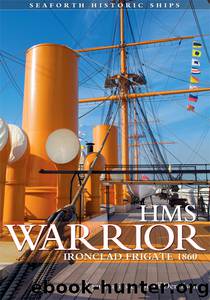HMS Warrior: Ironclad Frigate 1860 by Wynford Davies

Author:Wynford Davies
Language: eng
Format: epub
Tags: Bisac Code 1: TRA006010; TRANSPORTATION / Ships & Shipbuilding / History
ISBN: 9781848322837
Publisher: Seaforth Publishing
Published: 2011-08-16T16:00:00+00:00
NHS has produced several useful guidelines to aid restoration, but the work on Warrior was really at the forefront. Many of the lessons learnt form part of the accepted modus operandi of subsequent restorations, but occasionally there were to be failures. The upper deck planking turned out to be one such. During Warrior’s restoration steps had been taken to try and replicate the original pitch pine planking. This was no longer available in sufficient quantity or the correct sizes so some Finnish redwood of the right age was obtained from a derelict warehouse. Move forward a mere thirteen years and the planking was deteriorating rapidly and had to be replaced. In fact a solution had been worked out in some detail by the ship’s staff and a proposal put forward that would satisfy long-term objectives.
It is now almost axiomatic that any restoration carried out using funding from the HLF should be aimed at lasting for as long as the vessel had survived already. It is also recognised, particularly with warships, that the maintenance load has to be reduced considerably to take into account that most preservation groups or museums do not have a large crew that have to be kept occupied! In view of these two criteria a durable hardwood was selected for the new planking: best-quality Burmese teak, the epitome of shipbuilding timber. The new planking was laid by the Maritime Workshop from Gosport in the form of a modified ‘Chinese deck’. In other words, an air gap was introduced beneath the planks to ensure the timber was well ventilated and could drain effectively, thus preventing the bottom-up rot that had destroyed the redwood planking.
Though the bulk of the restoration was finished at Hartlepool, work still continues at Portsmouth under the auspices of the ship’s staff. Most recently work has commenced on restoring the sickbay as a visitor attraction, for example. In addition the bulwarks are now in need of some further attention and may have to be renewed. This should not be taken as criticism of the work done in Hartlepool, but as a reflection of the fact that all things age, some quicker than others.
One of the guiding influences in deciding whether this ship or that boat may be preserved is whether its future would be sustainable. HLF grants are predicted on the applicant producing a sustainable business plan and a ten-year maintenance programme. Common sense dictates that this should be so, but common sense can be as rare a commodity amongst ship enthusiasts as it seems to be elsewhere these days. However, in Warrior’s case the business plan has stood up to the test of time and looks like doing so for a while yet.
Download
This site does not store any files on its server. We only index and link to content provided by other sites. Please contact the content providers to delete copyright contents if any and email us, we'll remove relevant links or contents immediately.
| Dollhouses | Dolls & Doll Clothing |
| Miniatures | Model Trains |
| Models | Stuffed Animals |
| Toymaking | Wood Toys |
On Writing A Memoir of the Craft by Stephen King(4244)
The Doodle Revolution by Sunni Brown(4064)
A Simplified Life by Emily Ley(3590)
Mummy Knew by Lisa James(3179)
Marijuana Grower's Handbook by Ed Rosenthal(3139)
Paper Parties by Erin Hung(3050)
Better Homes and Gardens New Cookbook by Better Homes & Gardens(2972)
Figure Drawing for Artists by Steve Huston(2811)
Draw Your Day by Samantha Dion Baker(2722)
The Genius of Japanese Carpentry by Azby Brown(2623)
Japanese Design by Patricia J. Graham(2572)
Lions and Lace by Meagan Mckinney(2506)
Dangerous Girls by Haas Abigail(2488)
The Curated Closet by Anuschka Rees(2404)
How to Make Your Own Soap by Sally Hornsey(2357)
Zero to Make by David Lang(2354)
The Wardrobe Wakeup by Lois Joy Johnson(2245)
The Code Book by Simon Singh(2230)
The Checklist Manifesto by Atul Gawande(2217)
